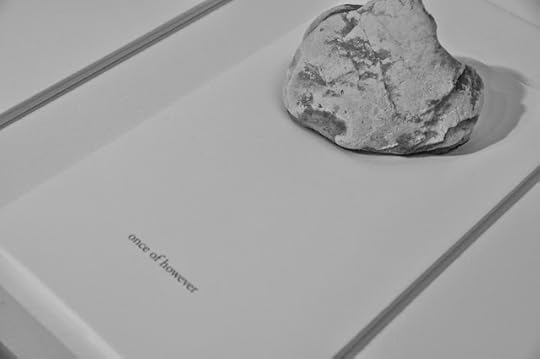I Wrote a Book Today
 Anna and Leo Daedalus, Ten Rocks with Their English Translations (copy f of h) (2011)
Anna and Leo Daedalus, Ten Rocks with Their English Translations (copy f of h) (2011)(Note that this book is a translation of rocks into English)
I thought I would be writing about one of the events in Portland today, but instead I read a book today, and that caused me to write a book, not a large book, but a book of hundreds of small poems, each written into the 400-page book I read today. I read and wrote for five hours as I moved through the skies (in a window seat with a wall instead of a window) from Portland, Oregon, to New York, New York. But I failed to write the introduction to the book on that flight, so I wrote it tonight on my train ride from New York to Albany. It is but a first draft, but this is all of this little book (one poem to a page it'll be about 200 pages long) for now.
* * *
(in parenthesis
frgmnts from the Greek
movements out of the English made of Sappho
INTRODUCTION
OF SAPPHO
Sappho (or, more properly and rarely transliterated,Psapfo) is the most famous Greek lyric poet, if not the most famous in theentire ancient world. For millennia she has been known as the tenth musebecause of her lyric skills: the power of her words, the subtlety andoriginality of her meter, and even the music she wrote (none of the last havingsurvived). A native of the Greek island of Lesbos from the sixth century BCE,she is the ultimate cause for the more general term "lesbian," which is aconcept born from her poems, where she often expresses some physical tendernesstowards women.
The power of Sappho's verse derives not entirely from theextant store of her poetry, which is quite paltry: a couple complete poems andalmost a couple hundred fragments, many of only a few words, or less. Thevividness of her verse comes from what is no longer there. It extends out ofthe lacunae in her verses, the blanks that we fill in with our minds or whichwe hear as gentle pauses within fragmented speech. We also believe in thebeauty of her verse because the ancients did; they extolled her verses, seeingin her a master poet. To some degree, the abated but still real controversyconcerning her supposed homosexuality, both draws the salaciously curious andthose who feel a need to honor the fact that homosexuality is a permanent humancondition. Although it is not a condition of most humans, it is one thatextends back in time before the ages when history was recorded.
None of this is meant to question whether Sappho is agreat poet. Even given the phrases she often repeats, the aching beauty and thetrue and various emotion of her poems comes through, here and there, in thefragments, and we are left to mourn what we have lost.
OF TEXT
Sappho is said to have written eight, sometimes nine,volumes of verse, so very little of her oeuvre survives, and what does is oftenof questionable authorship. Scholars disagree about what are true Sapphic poemsand what are the apocrypha. Many of the surviving fragments of her poems do nothave her name associated with them on the papyrus versions, and the questionremains how these poems may have changed through the repeated process ofscribal transcription over the centuries. The truth is that much of Sappho'spoetry is missing because of a concerted effort to destroy it—her apparentcelebration of lesbian love being more than many, especially the Christianchurch, could abide. Willful destruction probably has done more than centuriesof neglect to erase Sappho's verses, but never her, from our culturalconsciousness.
Her fragments (and those two complete poems) come to usin two separate ways: Most come to us in the moth-eaten form of fragments wherebits of the text have fallen away, leaving occasional gaps in the lines, theeliminations of the left-hand side of the poem, the loss of the end of thepoem, etc. Most of these fragments are quite short: under ten lines in length.These are the romantic remainders of Sappho, those that most people who know ofher imagine her poems to be. When Ezra Pound wrote his three-line andthree-word poem about the absence of Gongyla, he was hearkening back to thesefragmented pieces of Sappho. He ended each of his lines with ellipses totelegraph to us the voids in the poem, and it is precisely those voids thatmake the poems romantic and reverberating to us. The second way that Sappho'spoems come to us is much less romantic, and much more whole. Since Sappho was agreat poet of her age (and all the ages that followed), writers on rhetoric,poetry, and grammar often quoted lines from her verses to give examples ofwriting in action and to support their own points. Often these quotations camewithout any important focus on Sappho while inadvertently rescuing whole linesor two from Sappho. All of these are complete from beginning to end, so thereare no voids with these quotations, but each remains a fragment of a poem.
Most speakers of English have no ability to read ancientGreek, so they depend on translations to form any opinion on Sappho. I am thesame, so this book before you (mine, not Sappho's) is inspired by translationsby Anne Carson of Sappho into English. Carson is herself a great andmarvelously unique poet as well as a great scholar of the ancient world, so sheis probably the most likely person to translate Sappho well for us. For thatreason, I searched yesterday for her book, If Not, Winter: Fragments of Sappho,in Powell's flagship bookstore in Portland, Oregon, and I found a fine copy ofthe book itself with a fair dust jacket (a little soiled from wear and withsomething spilled on part of the top front edge). Today, I read the entire bookas I flew across the country, writing in it as I did.
Carson herself had to base her own translation on a text,and she chose Eva-Maria Voigt's Sappho et Alcaeus: Fragmenta, published inAmsterdam in 1971. Carson opted to translate only those fragments where atleast an entire single word was present. Every act of translation is a sequenceof choices, an attempt to make a different but similar whole out of anotherwhole. Some of these wholes are merely series of fragments.
When I opened Carson's book today, I did not expect towrite a book of poems from it, but I did expect it to engender a few smallpoems of mine, since I often write minimalist poems inspired by a word or aphrase I read in other poems. As I continued reading in this book, however, Inoticed that there was something about Carson's translation (unlike others Ihave read), something about her word choices and phrasings that encouraged meto respond to each poem, so I did. Using a mechanical pencil, I wrote a poem,almost always one line in length, somehow inspired by the poem on the page. Iloved the process, and I write only for the love of writing, not even foranyone to read what I make. Carson's translations were more understandable andmore literally inspiring than others I've read, so I have her to thank, but Ihave much else to thank her for. As I always say, all of our great poets now(poets writing in English) are women. In general, they seem more oral than men,and that deeper connection to the language, and the bravery they often show intheir writing, makes them better than us poor lesser sex of poetry. (I basethis only on the fact that all of the living poets I most love are women. Allof them.)
My little poems have the aura and style of othersequences of short poems I've written, especially those directly inspired byother poetry. This inspiration, however, may seem indirect, because I mightsometimes take a single word and make something almost entirely different ofit. The two poems might have no more than a single word in common. Often, inthis sequence, I do create poems out of words I find wandering in the text, orI riff off the words in the original text. This process of riffing extends intothe academic appenda in the back of the book, so my poems continue in the notesto the poems, and even to the glossary, that appear in Anne Carson's book.
This book does cohere, though; at least it seems so tome. It is a book governed by the interests of Sappho herself, so it is a bookabout love and desire. It reads as a book about relationships, and it iswritten to be such. Inspiration is one thing, but creation is another. Sapphoand Carson are my muses here; I am still the poet. All blame and disdain aremine to keep.
ON MARKINGS
The omnipresent markings in the book are the numbers thatidentify each poem. These numbers are not from me; these are the common numbersused to identify fragments of Sappho, and I must assume that the numberingsystem follows assiduously that of Eva-Maria Voigt's Sappho et Alcaeus. Withthese numbers, any reader can relatively easily return from my poems toSappho's originals to puzzle over how mine were created out of hers.
I do not follow Anne Carson's marking protocols at all.My marks do not designate, for example, lacunae in the Sapphic text. Instead, Iuse all markings simply as punctuation. I believe that punctuation is apowerful tool of meaning, one that creates more sense than we usually realize,and always silently, always by defining the type of pause we must take tounderstand something. So two square brackets facing each other, two of thesebetween a void, show that something is missing. If words are inserted betweenthose brackets, then those words are intruders inserted into the text from anomniscient source. Ellipses might show elision of words already in place ormight show the trailing off of a thought. Words between parentheses are asides,or extra thoughts whispered at the reader. Commas show brief pauses. Dashesdemonstrate a wrenching extension of a thought; colons show that what followsthe colon explains or deepens the meaning of what precedes it. Semi-colons showthat two separately expressed ideas are equal in value and meaning, thoughdifferent enough to require a semi-colon between them. Words between quotationmarks are supposedly quoted material; here they represent that someone isspeaking, probably someone other than the poet. Apostrophes show elisions intwo words brought together or mark, with the s, the possessive case in nouns.Hyphens hold the two unnatural parts of a compound word together. Virgulesrepresent slashes, which represent the line from John Berryman: "O and aslash." Question marks mark a sentence as a question.
There are no periods in the poems in the body of the book(except to mark abbreviations), just as there are no capitals starting eachpoem. Initial capitals and periods are relegated to the notes, which are alsopoems, but poems of reference back to other poems. They are poems constructedof the mechanics of scholarship, even though they are not scholarly.
Punctuation controls the making of sense. I usepunctuation to poetic effect, just as I use the pun. It is possible that all apoem needs to survive is punctuation and a pun.
6 November 2011
on a train heading north
from New York's Penn Station
to the Albany-Rensselaer Station
ecr. l'inf.
Published on November 06, 2011 20:59
No comments have been added yet.



